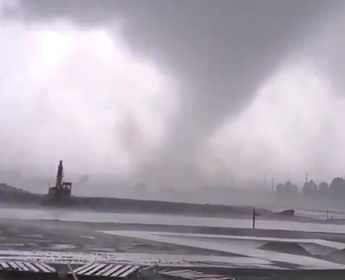Western University’s Northern Tornadoes Project (NTP) has determined four tornadoes struck different Ontario communities Thursday in addition to the one that wreaked havoc in southeast Barrie and Innisfil.
All five were determined to have wind speeds in the EF2 range, according to an NTP tweet posted at midnight Saturday.
The NTP’s ground and drone survey determined the Barrie tornado tracked 12 kms with a maximum path width of 600 metres at an estimated maximum wind speed of 210 km/h into Innisfil causing extensive home, car and tree damage and also sending 11 people to hospital.
According to the NTP 71 homes have been deemed uninhabitable.
NTP damage surveys have documented 5 different tornadoes generated by the storms of July 15th in southern Ontario, all of them having maximum wind speeds in the EF2 range. See details below. #ONStorm (1/2) pic.twitter.com/crZe0ZuoF3
— Northern Tornadoes Project 🇨🇦 (@westernuNTP) July 18, 2021
The NTP team is continuing its investigation which will include analysis of drone and satellite imagery.
Analysis by the project’s team found a second tornado tracked north of Zephyr, east of Lake Simcoe’s southern tail, eastward to Little Britain, which is west of Lindsay.
Most of the roof of one home was damaged, there was tree damage and one person suffered injuries. A ground survey was conducted.
The Zephyr tornado travelled at an estimated maximum speed of 195 km/h. Preliminary research shows it tracked 30 kilometres with a maximum width of 300 metres. Further investigation, including satellite imagery analysis is expected to provide more precise information including the length of the track and the number of tracks.
A third struck west of Lorneville, east of Beaverton, causing structural and tree damage as it tracked eastward toward Hartley. It travelled 13 kilometres with a maximum path width of 600 metres, travelling at an estimated maximum speed of 180 km/h.
The NTP team conducted a ground and drone survey and found a barn and a farm outbuilding were destroyed.
Tree damage was caused by the fourth in the Dwight area, between Huntsville and Algonquin Park.
That tornado began near North Portage. Satellite imagery showed it tracked a path 4.76 kilometres long, with a maximum width of 360 metres, travelling at an estimated maximum speed of 190 km/h.
The fifth struck in the northeast quadrant of Algonquin Park starting southwest of Lake Traverse. Satellite imagery revealed that tornado travelled at an estimated maximum speed of 190 km/h downing trees along an 11.9 kilometres path with a maximum width of 340 metres.
The NTP reports it is continuing its investigation into all five tornadoes.
Of the 10 days Ontario has been known to be hit with three or more tornadoes dating back to 1933, Barrie has been the worst hit community having experienced two devastating days, according to the NTP.
In addition to Thursday’s high-end EF2 tornado, an F4 tornado landed on Barrie back on on 31 May 1985. It was one of 12 tornadoes which found their genesis in the United States, claiming 12 lives in Ontario, eight of them in Barrie.
The Barrie tornado of 1985 skipped its way from the west near Angus and smashed into homes in the Patterson and Crawford roads area, crossing into Highway 400 at Essa Road into what was then the fairgrounds, up into the Allandale residential area, over to the Brentwood Marina and moving westward at Kempenfelt Bay.
The other days and areas recorded to have multiple tornadoes are:
- Three in Eastern Ontario on Sept. 21, 2018;
- Four in several areas in Southern Ontario on Aug. 20, 2009;
- Four in Northwestern Ontario on July 9, 2009;
- Three in Southwestern Ontario on May 2, 1983;
- Six in Southwestern Ontario on May 21, 1953;
- Three in Eastern Ontario on Aug. 30, 1947;
- Eight in the Greater Toronto Area on May 19, 1940;
- Six in Southwestern Ontario on June 7, 1933.



